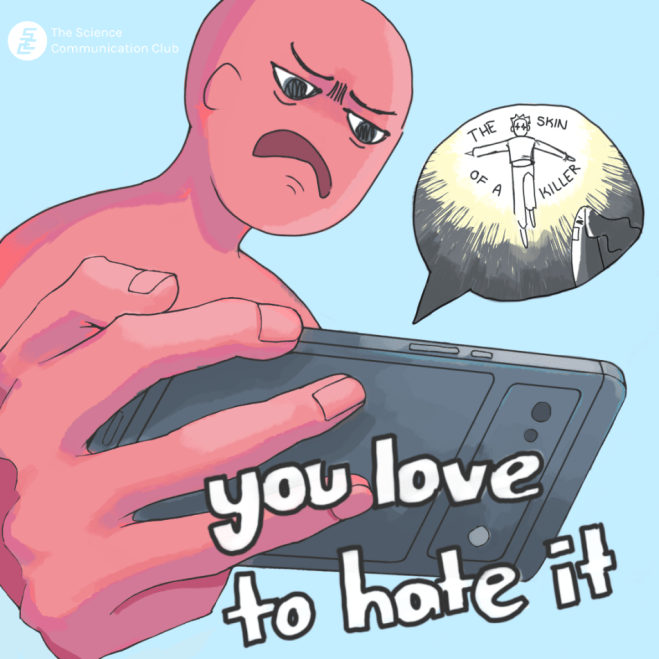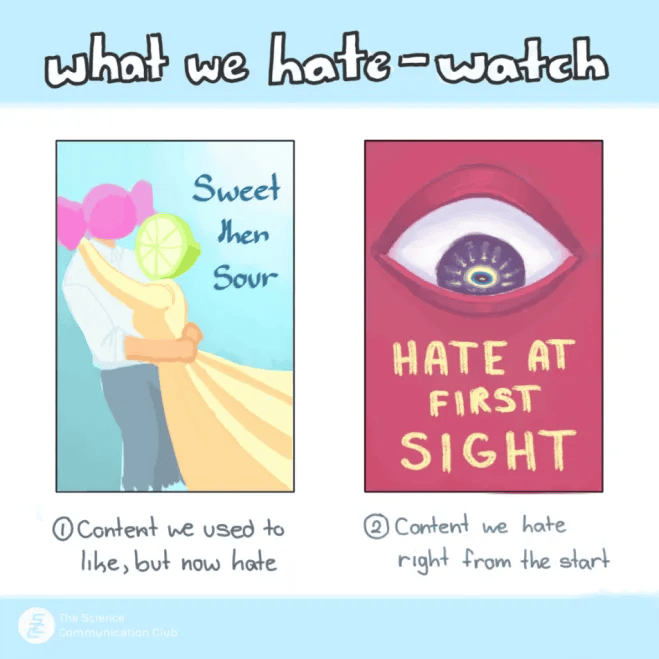
Written by Faiza Chowdhury
Illustrated by Sneh Boro
You sit down with a warm plate of food and turn on your device, hoping to decide on a watch before your food gets cold.
But, knowing in the back of your mind that 15 minutes from now, you’ll probably be chewing on a cold bite as you scroll through your streaming app.
Lamenting about not having anything “good” to watch, you either rewatch your comfort show for the 500th time, or, you tune into that new program that looks absolutely… dreadful.
You hate the actors, can’t stand the premise, and in some cases, don’t even know why this show got renewed after the last season had you pulling your hair out.
And yet you find yourself gravitating towards it anyway.
Sound familiar?
Because if you’re anything like me, that pretty much sums up my usual experience as a content-consumer.
I love to hate-watch, despite the bitter taste in my soul that the negative emotions leave; 40% of the things I watch, in my humble opinion, suck.
When faced with something that is so apparently displeasing, the obvious answer is to avoid it.
So why do we hate-watch?
And more importantly, what is hate-watching?
To hate-watch is to watch content that you dislike, intending to make fun of it¹.
This includes two types of content:
Content that we once appreciated, but have now come to hate.
Brand new content that we dislike from the first watch.

This article strictly explores research on hate-watching two specific pieces of streaming content: the WWE and the Netflix show Indian Matchmaking.
Research on hate-watchers of the WWE suggests that former fans of the franchise continue interacting with it by publicly commenting their dislike because of nostalgia, need for belonging and desire to see change in creative direction². Long-time watchers of the franchise find it hard to let go because they’ve invested too much time as fans and want to preserve those memories through their present relationship². Many hate-watchers engage with the content because interacting with other fans and anti-fans gives them a sense of belonging². The research also found that some individuals criticize the franchise because they want to see it revert back to its “glory” days. They seek change in the content and in a few instances explored in the paper, fans succeeded in that by voicing their displeasure².
Transitioning from a love to hate relationship is an understandable phenomenon that we all experience. Not only with content, but with other things as well, such as hyper-fixation foods. But hate-watching from our very first interaction with the content is a distinctly different experience.
Suryansu Guha, a Cinema Media Studies PHD student at UCLA, explores how to make a “hate-watch” by comparing two series on the subject of arranged marriages in the South-Asian community: A Suitable Girl (ASG), and Indian Matchmaking (IM)³. While both shows share a character and high-ranking crew member, the latter was widely known as “Cringe-Binge TV”³.
Both ASG and IM follow Seema Taparia, a matchmaker based in Mumbai, India, as she attempts to arrange marriages for several of her clients. ASG is shot within India, featuring only Indian clients whereas IM is also shot abroad, featuring clients from the South-Asian diaspora alongside Indian clients. Despite both series revolving around arranged marriages, a tradition which is controversial amongst South-Asian communities, Guha attributes the widespread hate-watching of IM to the production aesthetics and the producer led marketing of the show, implying that they manufactured a “hate-watch” for the audience and it is not simply an adverse reaction to subject matter³.
ASG was shot using documentary realism, portraying ordinary middle class people and lifestyles, which are more relatable to the public “[…] in stark contrast to the upbeat, vivacious, heightened display of extravagance in Indian Matchmaking”³. In an interview with Guha, Smriti Mundhra, the show-runner of (IM) and director of ASG, stated that both shows had participants of a similar class breakdown³. Guha, I, and many of my friends that watched the show agree that the clients in IM did not come across as “ordinary middle class” people.
In Guha’s interview with other crew members, they reveal that Netflix strongly influenced the “look” of the show³. Alongside this, Netflix also commissioned comedian Youtubers, famous for roasting content, on the Netflix India channel to review the show, sparking the hate-watch narrative among audiences³.
In my search to answer “why we hate-watch” I found that hate-watching can be both a curated effect and an organic reaction to content we once loved. This raises important questions about the way we interact with and react to content and the authenticity of our perspectives.
So next time we sit down to hate-watch a new show, let’s ask ourselves…
Do I truly dislike what this content represents?
Or am I being called to hate this content by its creators?
Sources:
- Hate-watch definition & meaning. Dictionary.com. [accessed 2025 Mar 18]. https://www.dictionary.com/browse/hate-watch
- Vosen Callens M, Westerman DK, Cross AC. Why We Hate-Watch: The Role of Nostalgia and Investment in WWE Viewership. The Journal of Popular Culture. 2023 [accessed 2025 Mar 18];56(1):70–90. https://onlinelibrary-wiley-com.myaccess.library.utoronto.ca/doi/10.1111/jpcu.13207. doi:10.1111/jpcu.13207
- Guha S. Making a “hate-watch”: Netflix’s Indian Matchmaking and the stickiness of “Cringe binge tv.” Television & New Media. 2022 [accessed 2025 Mar 18];24(8):870–893. https://journals.sagepub.com/doi/abs/10.1177/15274764221095792?casa_token=39jaxgJrZccAAAAA:es9R0BMPYbRQWVQ_dxssjv4k1jyB_N3eByUER-wnrIJs0PJWHLTP-h8JVgOXrOPKHzCQs5nr0zBJ&casa_token=uhNUzLESoKwAAAAA:-oRk9_QmqozWw1VLVAP87vPFH_c8nJCTgtevX4yBGn_fgFfZMyeLUeGMDBiIrlSnqh8I6XIbH4I8. doi:10.1177/15274764221095792